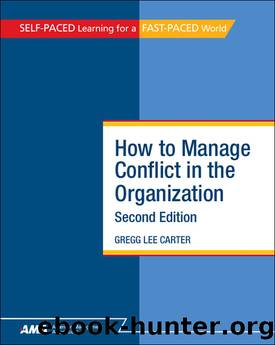How To Manage Conflict in the Organization by Gregg Lee Carter & Joseph F. Byrnes

Author:Gregg Lee Carter & Joseph F. Byrnes
Language: eng
Format: epub
Publisher: AMACOM Books
Published: 2006-10-15T00:00:00+00:00
Some managers may not feel comfortable coaching employees. They think it places them in the role of therapistâa role they feel ill-equipped to play. Or they simply prefer the direct approach and a massive use of their authority: âChange, or else!â As we have already pointed out in this chapter, and as we do so many other places in this course, such a mind-set is becoming more and more out of step with the cultures of most contemporary work organizations, which increasingly emphasize equality, equity, and employee input in maintaining and improving company operations.
Indeed, it is our experience that the number one way in which organizations can avoid the kind of costly litigation and the more expensive forms of ADR (alternative dispute resolution) discussed in Chapter 1 is to encourage their managers and team leaders to treat their coworkers and subordinates with respectâto be tough on logic, to be tough on data, but to be soft on people (a bedrock idea underlying coaching as well as the principled negotiation approach to conflict resolution emphasized throughout this course). We have found that by following the guidelines in Tools 4â2, 4â3, and 4â4, most managers can become skillful at coaching, and that most organizations will fare better when their managers make it a common alternative in resolving interpersonal conflict.
Consider the following coaching session between Carol Freedman and her abrasive production supervisor, Jorge Lopez. Pay attention both to what Carol says and to how she says it:
JORGE: I donât know why you want to talk to me. The problemâs Chuck Simmons. Sometimes I think heâs in perpetual slow motion.
CAROL: (Maintaining eye contact) Jorge, do you really think that Chuckâs the whole problem?
JORGE: No, of course not. I know I fly off the handle sometimes. He can be so aggravating and Iâm an impatient guy. I canât stand waiting around for anybody.
CAROL: (Friendly, empathetic tone) Jorge, I know you donât want to fight with Chuck all the time. So what can you do to minimize the conflict?
JORGE: Leave the department whenever Chuckâs aroundâthatâs what I can do. I canât yell at him if Iâm not there.
CAROL: (Raising the pitch of her voice) Thatâs an idea. Do you think it would really work?
JORGE: Probably. Iâm certain I waste even more of my time by arguing with Chuck. And Iâm convinced he slows down to spite me when I get mad. If Iâm not there, Chuck and his guys would take less time, and my blood pressure would stay normal.
CAROL: (Maintaining eye contact; friendly, empathetic tone; raising the pitch of her voice) Well, would you like to give it a try? Get out of the department whenever the maintenance people show up?
JORGE: I canât do it all the time. But I can try it and see if it works. It certainly couldnât make the situation any worse.
A careful examination of Carol Freedmanâs part of the dialogue reveals that she followed Nierenberg and Ross recommendations by using a subtle approach. Most of the time she asked questions. This enabled Jorge Lopez to crystallize his thoughts.
Download
This site does not store any files on its server. We only index and link to content provided by other sites. Please contact the content providers to delete copyright contents if any and email us, we'll remove relevant links or contents immediately.
Cecilia; Or, Memoirs of an Heiress — Volume 1 by Fanny Burney(32434)
Cecilia; Or, Memoirs of an Heiress — Volume 2 by Fanny Burney(31871)
Cecilia; Or, Memoirs of an Heiress — Volume 3 by Fanny Burney(31854)
The Lost Art of Listening by Michael P. Nichols(7406)
Asking the Right Questions: A Guide to Critical Thinking by M. Neil Browne & Stuart M. Keeley(5635)
We Need to Talk by Celeste Headlee(5542)
On Writing A Memoir of the Craft by Stephen King(4863)
Dialogue by Robert McKee(4321)
Pre-Suasion: A Revolutionary Way to Influence and Persuade by Robert Cialdini(4150)
I Have Something to Say: Mastering the Art of Public Speaking in an Age of Disconnection by John Bowe(3840)
Elements of Style 2017 by Richard De A'Morelli(3307)
The Book of Human Emotions by Tiffany Watt Smith(3238)
Fluent Forever: How to Learn Any Language Fast and Never Forget It by Gabriel Wyner(3028)
Name Book, The: Over 10,000 Names--Their Meanings, Origins, and Spiritual Significance by Astoria Dorothy(2939)
Good Humor, Bad Taste: A Sociology of the Joke by Kuipers Giselinde(2903)
Why I Write by George Orwell(2874)
The Art Of Deception by Kevin Mitnick(2736)
The Grammaring Guide to English Grammar with Exercises by Péter Simon(2710)
Ancient Worlds by Michael Scott(2625)
